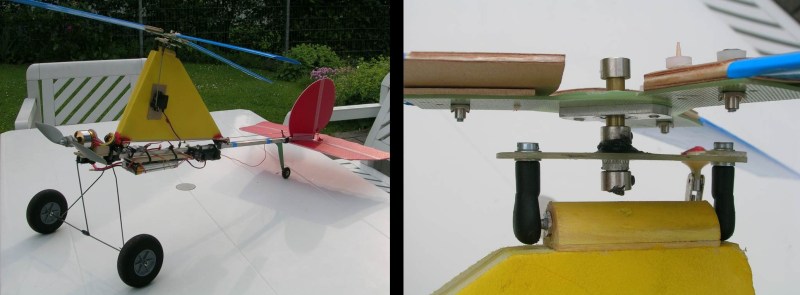Out in the RC Airplane world, there is a great airframe called the Slow Stick. There is not much going on with this plane as it only has the bare necessities, a motor, wing, tail and a fiberglass tube (hence the ‘stick’ part of Slow Stick) as the fuselage. Yes, and as the name suggests it is slow. Although it’s intent is to be a starter plane for beginners, even experienced pilots like it because it is cheap, easy to repair and fun to modify. [StephanB] is the type of guy who likes to modify things so he set out to convert his Slow Stick to an Autogyro.
An Autogyro can be described as a cross between a plane and a helicopter. Like a plane it has a propeller that provides forward thrust. Unlike a plane, it does not have a wing. To provide lift, there is a large helicopter-like rotor on top of the craft but this rotor is not powered. It only spins when the craft is moving forward. Lift is created when the rotor is spinning, allowing the Autogyro to take off.
[StephanB] started by removing his Slow Stick’s wing. This takes all of 2 seconds and consists of only removing 2 rubber bands. Next he built a frame for the rotor. It was made to fit the wing mounts of the Slow Stick so that it could be quickly converted back to a plane. With a spinning Autogyro rotor, the side that the rotor is traveling in the forward direction creates more lift than the side of the rotor traveling rearward. To compensate for this unequal lift, [StephanB] added a sideways tilting rotor mount. An RC servo is connected to the mount and allows remote control of the rotor to balance out the lift.
















“Unlike a plane, it does not have a wing.”
Aircraft are two general categories; fixed wing and rotary wing
An autogyro is a rotary wing. Don’t ask me where the V-22 Osprey fits…
oh it’s a fixed-wing airplane. but its props are so stonkin’ huge it can helo with them
Although it is a rotary wing, Its really a disk – from an aerodynamic POV. Check out http://pra.org/
The fact its not driven is the difference.
It was done in 2007
I love autogyros! When is the RC zeppelin article coming? (And I’m not being sarcastic I really do think autogyros and zeppelins are neat.)
What book would you suggest to a newbie who would like to design and build his own flying thing? I mean the bare math and physics necessary to design from scratch something that flies, building techniques, tricks and caveats etc.
If you are talking about models then just about any book on model aircraft will give you a good start.
It is not that hard to make things that fly, just look at any cheap gullow gliders. It is hard to get really high performance out of them.
Honestly, save your money for gear and materials. Read forums like RCgroups and watch youtube build channels (Flitetest comes to mind but I’m sure there’re others). These communities are amazingly helpful and have more information in them than any book could hold.
You don’t need to understand the hard math side of aeronatuics to get an RC plane in the air. The materials are cheap enough ($3-5 bucks for a sheet of foamcore) that you can brute force a build if the first one won’t get off the ground. Start with a couple proven designs (Zagnuts, Funbat, or the many commerical kits) before working on your own designs and you’ll get a sense for what should fly.
You can solve quite a few challenges by putting a more thrust on the same airframe (they do it in real planes e.g. the F-15).
A triumph of thrust over aerodynamics, as it were…
http://www.theminiaturespage.com/boards/msg.mv?id=239985
What’s that saying? Something like “gliders float on the air, helicopters beat the air into submission”
“Never trust an aircraft whose wings go faster than its fuselage”
I hear good things about the EasyStar (or its numerous successors, clones and homages), made of styrofoam. Try starting from forum posts about it.
Check out this guy’s youtube channel, “Experimental Airlines”
He has a cool foamboard technique that’s very low-cost but look great
https://www.youtube.com/watch?v=bta80gyHK7Q
There’s a video (http://www.rcgroups.com/forums/showthread.php?t=694138#post7559371 ) but it’s a wmv download and I’m on a Chromebook right now so I can’t vouch for it.
Here you go.
https://www.youtube.com/watch?v=nP_rp3KraCs
For all the love quadcopters are getting these days, it’s nice to see some coverage on more “traditional” flying machines.
Holy Shit this is dangerous for me… All i see it build it bigger, build it ride-able, build it fly-able.. and i think i’ve got the shit on hand to try it
Compensating for the difference in lift between the advancing and retreating blades is easy. Take a close look at the deceptively simple gyrocopter’s gimbal head. It’s really a cyclic pitch control, though few people realize it. Since the teetering rotor blades rock end to end, but not side to side, it actually reduces the pitch of the advancing blade and increases the pitch of the retreating blade. As you tilt the gimbal, the rotor’s cyclic pitch changes till the rotor is flying in the new plane.
Reminded me of this:
http://surbrook.devermore.net/adaptationsmovie/madmax/gyrocopter.jpg